PART III—
THE GRANDES CHRONIQUES OF KING CHARLES V
Chapter Five—
The First Stage of Execution (before 1375)
During the reigns of the first Valois kings, manuscripts of the Grandes Chroniques de France continued to offer different visual solutions to the problem of illustrating the chronicle. This situation changed when Charles V became king in 1364. Charles commissioned a continuation of the Grandes Chroniques that added accounts written at court about his father's and his own reign to the traditional history written by the monks at Saint-Denis about the Merovingians, Carolingians, and Capetians.[1] The copy of the Grandes Chroniques (B.N. fr. 2813) that this continuation expanded became an authoritative manuscript influencing a generation of royal and courtly books.
Charles V's manuscript incorporated the history of a new branch of the Capetians—the Valois—into the official history of the French kings at a time when the English crown was challenging the legitimacy of the Valois rulers. The addition of this new illustrated text to the king's copy of the Grandes Chroniques was a timely reaction to contemporary politics and a typical one for this bibliophile king.[2]
This version of the Grandes Chroniques took its present form in a series of four distinct campaigns of systematic modification and amendment[3] that enable us to trace the evolution of the complex interplay of words and images that characterizes Charles V's book. During the first stage of execution Henri de Trévou, the first scribe, wrote a two-volume chronicle that ended with the life of Philip of Valois. In the second stage of work Raoulet d'Orléans, the second scribe, introduced running titles, changed the last folios of the life of Philip of Valois, and added the narrative of the lives of John the Good and Charles V up to the events of 1375. During the third stage of production Raoulet d'Orléans recorded events from fall 1375 to spring 1379 and inserted five sets of text and miniatures into the first portion of the manuscript.[4] The fourth and final stage occurred in the fifteenth century when the manuscript was rebound into one volume.
Because it dates from three distinct moments in Charles V's reign (before 1375, before 1377, and after 1378), this manuscript offers a rare opportunity to reconstruct the genesis and expansion of a political program. During the second and third stages of production the editors of the manuscript altered the focus of the original decorative program to reflect current political concerns by adding new text and miniatures and, on rare occasions, by substituting new text and illustrations for those in the first section of the manuscript. Pictures added in these stages refer
to miniatures in earlier segments of text, either by adopting parallel formats or by using similar iconographical detail. These references provide secondary levels of interpretation to the text that become comprehensible when we analyze the three different versions of the manuscript as separate entities.
Miniatures decorating the first portion of Charles V's book are the least complicated in placement, format, and content. Usually positioned at the head of major divisions in the text, these images are, with few exceptions, one column wide. They depict coronations, battles, or court scenes in a generalized fashion. Perhaps because of their straightforward portrayal of events, these pictures have not been a subject of study.
Nevertheless, certain texts and illustrations in the first part of the manuscript are especially noteworthy. The hierarchy of decoration within the pictorial cycle; the relationship of Charles V's manuscript to its textual model, which also doubled as a maquette or dummy for the disposition of miniatures; and the divergences in the program of Charles V's Grandes Chroniques from that of a small group of manuscripts that closely copy it suggest that certain illustrated segments of the text were particularly important to the king. The lives of Charlemagne, Louis the Pious, Philip Augustus, and Saint Louis clearly have special significance, and the history of the early Norman dukes is detailed with a precision found in no other version of the Grandes Chroniques .
The format of certain miniatures presented as large double or four-part pictures distinguishes them as more important than other illuminations in the book. For example, the frontispiece to the manuscript (fol. 4) is a large image encompassing four scenes. The first pictures for the lives of Charlemagne (fol. 85v), Louis the Pious (fol. 128), Philip Augustus (fol. 223), and Saint Louis (fol. 266v) are all double miniatures. Double miniatures also illustrate two scenes from the story of Roland (fols. 124, 128).
Philip III's Grandes Chroniques (Ste.-Gen. 782), the model for a large portion of the text, provides further evidence for the significance of text, miniatures, and subcycles dealing with the dukes of Normandy, Charlemagne, and the concept of legitimacy. Kept in the royal library, this manuscript contains fourteenth-century marginal annotations addressed to Henri de Trévou, the scribe of Charles V's manuscript.[5] These dictate the placement or, in one case, the suppression of miniatures in Charles's chronicle and advocate the rearrangement of certain texts. Almost all these dictates were acted upon.
Two differences between Philip's Grandes Chroniques and Charles V's are unheralded by the marginal notes directed to Henri. These address the problem of legitimacy; they include the suppression of the chapter on Hugh Capet, the first of the Capetian line, and the introduction from another source of the life of Louis VIII, which had not yet been written when Primat completed his translation.
Four later books modeled on Charles V's Grandes Chroniques stress many of the same texts and include miniatures of the same subjects. Yet a comparison of these manuscripts suggests that certain innovations in the program of Charles V's book appealed to a narrow audience. For example, a manuscript of unknown provenance (Lyon, B.M. 880); two texts owned by Charles V's son, Charles VI (B.N. fr. 10135 and fr. 2608); and one owned by Charles VI's chamberlain, John of Montaigu, (Vienna, ÖNB 2564) neither omit Hugh Capet's life nor place great emphasis on the history of the Norman dukes. These features are unique to Charles
V's manuscript.[6] A comparison of these manuscripts also suggests that the dense cycle illustrating the life of Saint Louis may have had a special significance for certain kings of France since it appears only in Charles V's and Charles VI's copies.
Politics in the Duchy of Normandy
Charles V's interest in the history of the Norman dukes is not surprising in light of contemporary events. In the mid-1350s John the Good made Charles duke of Normandy.[7] In this capacity he had to contend with the attempts of his cousin, Charles of Navarre, to foment rebellion from his base in Evreux as part of an attempt to win the French throne. The situation was complicated by the activities of the English king, Edward III, a second claimant to the throne who periodically invaded Normandy. Charles V's attempts to gain control of Normandy were successful. With the Treaty of Brétigny in 1360 and Charles of Navarre's homage at Vernon in 1371, Charles V made tentative peace with his rivals. Nevertheless, as the French land closest to England, the duchy of Normandy remained a point of contention throughout Charles V's reign.
Charles's role as duke of Normandy may explain the pictorial emphasis on the lives of Norman dukes in his chronicle. By emphasizing a number of events in the history of the early dukes, rubrics and illustrations introduced into the book establish parallels between Charles's ducal predecessors and his royal ancestors. Some of the textual changes specified in the margins of Philip III's Grandes Chroniques highlight the activity of the early Norman rulers. First, they suggest the inclusion of new rubrics that increase the prominence of Dukes Rollo (Robert I) and Raoul of Normandy and Kings Louis, Lothar, Robert II, and Henry of France. In addition, they advocate the subdivision of certain chapters to stress divine intervention in the conquest of Normandy (the appearance of Saint Benedict to Count Sigillophes), emphasize the Christianity of the early dukes (the baptism of Rollo at which he took the name Robert), and discuss treachery against the Normans (the treason of the count of Flanders). They also note the Normans' ability to seek peace (alliance with King Lothar of France) and praise their repulsion of an English invasion (by Ethelred II) and their willingness to go on crusade. The only chapter formed by subdivision that deals with a French king discusses Robert II's generosity to the abbey of Saint-Denis just before his death.
The placement of miniatures, also noted in the margins of Philip's Grandes Chroniques , places equal emphasis on the importance of the Norman subcycle. For instance, the only annotation recommending suppression of an image occurs on folio 209 (Figs. 12 and 69), where a note to Henri suggests that he skip a miniature depicting Richard of Burgundy chasing the Normans out of his realm in order to insert a picture of the Normans landing in Neustria, two paragraphs later, at the commencement of the description of Rollo's activities. Three other miniatures illustrate chapters created by the subdivision of this portion of Primat's text.[8]
These newly subdivided chapters describe traits in the Norman predecessors of Charles V that were normally attributed to French kings. Chapters focusing on divine sponsorship, the repulsion of an English invasion, and the willingness to crusade illustrate kingly behavior. One chapter is subdivided to introduce a miniature celebrating the baptism of Rollo (Fig. 70), the first Christian duke of
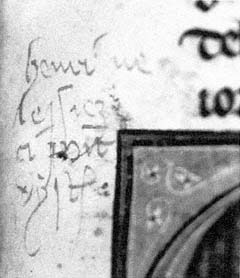
Figure 69
Inscription addressed to Henri de
Trévou. Grandes Chroniques de France .
Bibliothèque Sainte-Geneviève, Ms. 782,
fol. 209. Photograph by the author.
Normandy. This event parallels the baptism of Clovis, the first Christian king of France. Clovis's baptism was especially important to the French kings because, according to legend, the holy unction that distinguished the French rulers from all others first appeared at Clovis's baptism.[9]
Saintly Ancestors as Models of Kingship
Charles V's political motives also explain the dense cycles of the lives of Charlemagne and Saint Louis, particularly since no visual models have been found for them. Charlemagne's importance for French kingship and his special significance to Charles V must have been a factor in the elaboration of this sequence of illustrations.[10] Charles had a chambre de Charlemagne in his Hôtel Saint-Pol and was often compared to Charlemagne in the prefaces of works that he commissioned, such as Raoul de Praelles's translation of the City of God in 1375.[11] Charles V was the first French king actively to promote the cult of Charlemagne. In a speech delivered in 1378 Charles even referred to "saint charlemaine," a status that Charlemagne was not usually accorded.[12]
As Charles V's only canonized ancestor, Saint Louis also earned a special place in the Grandes Chroniques . Devotion to Louis was widespread, particularly among his Capetian descendants, who commissioned numerous cycles of his life. Charles V's densely illustrated version of Saint Louis's life continues this Capetian tradition but may also assert the legitimacy of the new Valois line, as in John the Good's Grandes Chroniques .
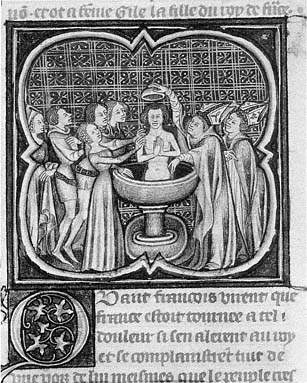
Figure 70
The baptism of Rollo. Grandes Chroniques de
France . Bibliothèque Nationale, Ms. fr. 2813, fol.
166v. Photograph: Bibliothèque Nationale, Paris.
The French Kings and the Empire
One image in the first version of Charles V's Grandes Chroniques , given special prominence by its format, may express the desire of the French kings to assert their independence of and equality with the Holy Roman Emperor. The four-part miniature (Fig. 71) preceding Book I illustrates the Greeks landing in Troy, their assault on the city, Francion founding Sicambria, and the defeat of the armies of Emperor Theodosius by Trojan descendants. The emperor's defeat is strongly emphasized. As the imperial army flees the Trojan onslaught, the emperor tumbles from his horse to land prominently in the foreground. The miniature clearly celebrates the Trojan ancestry of French kings: in the final, triumphal scene, for example, the Trojan king wears a tunic strewn with fleurs-de-lis, and his horse is richly draped in material of the same pattern. The triumph of the Trojans over the Roman emperor is therefore emblematic of the independence of France from the empire, as stressed in contemporary political theory.
Such comparisons of royal and imperial status are restricted to royal manuscripts. The frontispiece to one of Charles VI's Grandes Chroniques (B.N. fr. 10135), which copies Charles V's manuscript (Fig. 72), is identical in composition
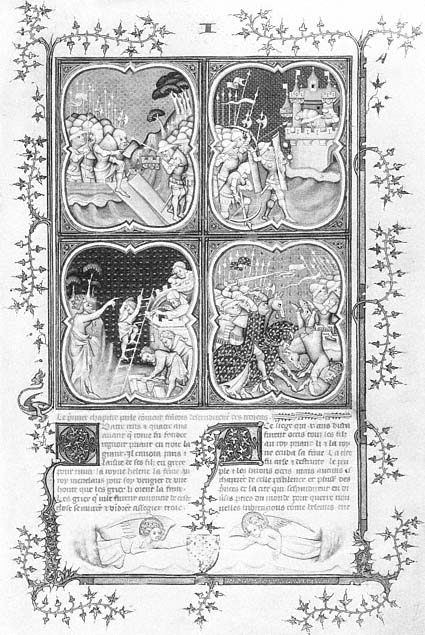
Figure 71
Greeks landing in Troy; Assault on a city; Francion founding Sicambria;
Trojans defeat imperial army. Grandes Chroniques de France . Bibliothèque
Nationale, Ms. fr. 2813, fol. 4. Photograph: Bibliothèque Nationale, Paris.
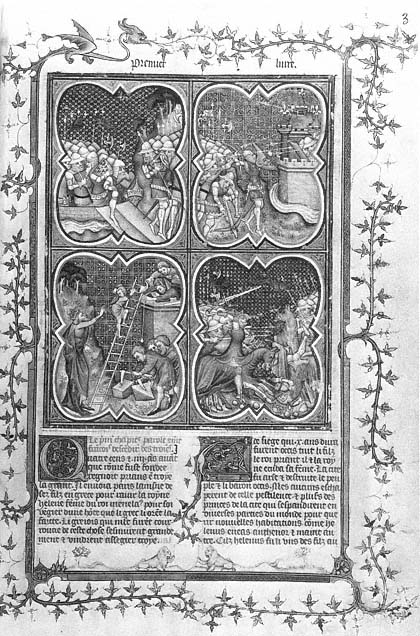
Figure 72
Greeks landing in Troy; Assault on a city; Francion founding Sicambria;
Trojans defeat imperial army. Grandes Chroniques de France . Bibliothèque
Nationale, Ms. fr. 10135, fol. 3. Photograph: Bibliothèque Nationale, Paris.
to this four-part miniature. It includes the image of the fallen emperor and signals the French presence by fleur-de-lis finials atop the towers of Troy. A third frontispiece from a contemporary, nonroyal Grandes Chroniques (B.N. fr. 17270, fol. 2v) also copies the four-part composition of Charles V's manuscript, but it suppresses the fleur-de-lis of France and the tumbling emperor. Although justified by the narrative, the careful equation of the Trojan and French kings and the inclusion of the fallen emperors in the two royal manuscripts elaborate upon their texts. The nonroyal manuscript omits any such elaboration, although the editor would have been familiar with the royal versions.
Dynastic Legitimacy and the Reditus
Charles V's concerns with the legitimacy of dynastic succession probably caused the suppression of the chapter on Hugh Capet when Charles's book was copied from Primat's presentation copy. The first portion of the suppressed text advances the doctrine of the reditus regni ad stirpem Karoli Magni . This was desirable material but could easily be omitted because the interpolated life of Louis VIII reiterates and expands upon the reditus theme. The second portion of Hugh Capet's life may have been the section that led to the chapter's suppression. In describing Hugh's reign, it includes an episode in which Hugh unjustly imprisons Arnoul, the archbishop of Reims, because Arnoul, though a bastard, is descended more directly than Hugh from the line of Charlemagne. As a result of his abuse of kingship, Hugh Capet is excommunicated. Only when Arnoul is freed and restored to his post is the ban lifted. Hugh Capet's fear of an illegitimate descendant of Charlemagne and the implication that Hugh was not a legitimate ruler may have provided sufficient reason for suppressing the passage in Charles V's book; it was uncomfortably close to events surrounding the Valois succession to the Capetians, when English claimants believed that they were more closely related to Saint Louis than were the Valois kings of France.
Hugh's life could be skipped without disrupting narrative continuity, because the chapters that precede and follow it provide a smooth transition. Charles of Lorraine's life ends by noting that after Hugh Capet ensured the extinction of Charlemagne's line, he had himself crowned in the city of Reims, and the life of Hugh Capet's son Robert begins with the statement that after Hugh died, Robert became king. Revisions in the text of Charles's chronicle thus ensured that the Capetians succeeded the Carolingians with a minimum of controversy.
Notes to Henri de Trévou in Philip's book reinforce the idea that the textual editing deliberately minimized questions about Hugh's legitimacy as ruler. The note to Henri in the margin of Hugh Capet's life in Ste.-Gen. 782 is the only one to show equivocation on the part of the designer. It originally consisted of the word "hyst," meaning "miniature." But "hyst" is crossed out and replaced by the words "une vignette," meaning "historiated initial"—"une" placed to the right of "hyst" and "vignette" to the left, thus downgrading the illustration originally planned for the passage on Hugh Capet.[13] Ultimately the picture was downgraded even further when this note was erased (it is now visible only under ultraviolet light) and the life of Hugh Capet was omitted from Charles V's chronicle.
In Charles's Grandes Chroniques the illustration to the life of Louis VIII, the only other text to deal explicitly with the reditus and with dynastic change also minimizes the turbulence of the transition from Carolingian to Capetian government. Instead of featuring Louis's coronation or his actions in Aquitaine, as do virtually all earlier copies containing this text, this picture (Fig. 73) illustrates a prophecy that fixed a time for the reditus and provided a reason for the transition from Carolingian to Capetian government. According to this prophecy, Saint Valery rewarded Hugh the Great, the father of Hugh Capet, for translating his body and that of Saint Riquier. To thank Hugh the Great, Saint Valery appeared to him in a dream and revealed that Hugh's descendants would reign as kings of France for seven generations—precisely the amount of time between Hugh Capet and Philip Augustus, whose son Louis VIII fulfilled the reditus .[14]
By illustrating the Valerian prophecy, the miniature beginning Louis VIII's life leads the reader to skip over the preliminary materials of the chapter, which describe Hugh Capet's usurpation and the reditus , and to dwell on the miraculous promise to Hugh Capet's father, here shown as a king. As the Grandes Chroniques
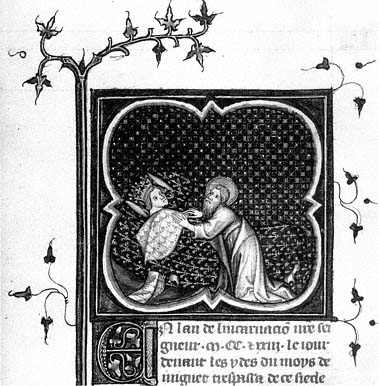
Figure 73
Saint Valery appears to Hugh the Great. Grandes Chroniques
de France . Bibliothèque Nationale, Ms. fr. 2813, fol. 261.
Photograph: Bibliothèque Nationale, Paris.
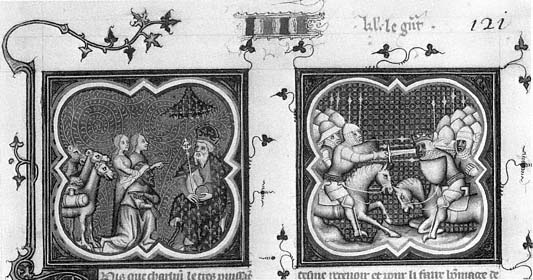
Figure 74
Charlemagne receives gifts; battle. Grandes Chroniques de France . Bibliothèque Nationale, Ms. fr.
2813, fol. 121. Photograph: Bibliothèque Nationale, Paris.
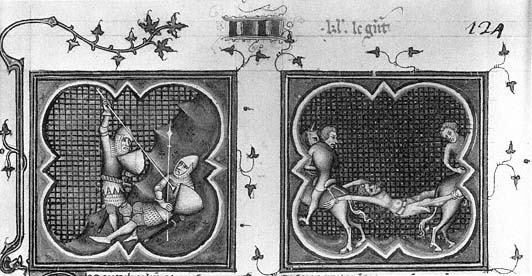
Figure 75
Combat determines Ganelon's guilt; punishment of Ganelon. Grandes Chroniques de France .
Bibliothèque Nationale, Ms. fr. 2813, fol. 124. Photograph: Bibliothèque Nationale, Paris.
states, Saint Valery's promise made it clear that the translation of the realm from Carolingian to Capetian was Hugh's reward for good works: his accession was a gift from God.
Kingly Behavior
The ideal of kingly behavior is the final theme featured in the program of Charles V's Grandes Chroniques at the end of the first stage of execution. This theme affected the rearrangement of chapters in the lives of the early dukes of Normandy, discussed earlier in this chapter. It also explains the inclusion of double miniatures in the story of Roland.
Two double miniatures from the life of Charlemagne represent a kingly prerogative: meting out justice in a just cause. Charlemagne's life was much more densely illuminated in Charles V's Grandes Chroniques than in its textual model; a cycle of nineteen miniatures replaces the five decorating the earlier book. Of the miniatures in Charles's codex, two in particular were laid out with special care. Twice in Book V of the life of Charlemagne (the story of Roland) a notation dictated that space should be left for a double miniature, a form of decoration that occurs only four times in over 380 folios and that in every other case heads the first chapter of a king's life.[15] These pictures illustrate a crime and its punishment. A double miniature (Fig. 74) represents the gifts sent as a false sign of peace to Charlemagne by Marsile, the Saracen king, with the help of Ganelon, one of Charlemagne's trusted advisors, and the subsequent battle in which Ganelon's treacherous act results in the slaughter of Charlemagne's men. The second pair of miniatures (Fig. 75) shows the just punishment for Ganelon's treason against a king. In one image the outcome of single combat determines Ganelon's guilt; in the second picture Ganelon is quartered by two horsemen.
The part of Charles V's manuscript written by Henri de Trévou is illustrated by generalized images, but these pictures nonetheless express ideas that become increasingly important in the formation of the program of illustration in subsequent continuations of this Grandes Chroniques . Through the rearrangement or suppression of texts and the importance accorded certain miniatures by their different formats, the first portion of the Grandes Chroniques focuses attention on Charles V's rights to Normandy, emphasizes the continuous descent of Capetian from Carolingian, and stresses the importance of saintly ancestors and just behavior. Finally, it highlights rulers of France who were also emperors and may assert the power of the French king vis-à-vis the emperor.
Chapter Six—
The Second Stage of Execution (c. 1375—77)
In contrast to the first stage of production of Charles V's Grandes Chroniques , which recorded French history from the fall of Troy to the death of Philip of Valois in 1350, the second portion describes only 25 years, from the accession of John the Good in 1350 to the ordinance of 1375, which established the age of majority for French kings at 14.
The quarter century recorded in this portion of the Grandes Chroniques was a time of marked change in the political fortunes of France.[1] Early in his reign John the Good, Charles V's father, was captured by the English at the Battle of Poitiers in 1356. Charles then began a gradual consolidation of power, first as lieutenant de roi and regent during his father's captivity and finally as king after John's death in England in 1364. The text reports a string of successes for the French house: the negotiation of a tentative peace with England; the suppression of rebellions fueled by Charles V's relative, Charles of Navarre, in Paris and Normandy; the homage of Charles of Navarre before Charles V; and, most important, the birth of a royal heir to Charles V and Jeanne of Bourbon.
A cycle of 26 miniatures faithfully mirrors the events recorded in the text. Most of these miniatures depict Charles's struggle with Étienne Marcel, the provost of Paris, or with Charles of Navarre, a claimant to the French throne. A second, smaller group of miniatures celebrates positive events of the reign by depicting important ceremonies. The large scale of these ceremonial pictures and their attention to details of costume and armorial bearings establish their importance. Their images evoke two broad themes: the idea of French supremacy over the English through the glorification of ideals of kingly behavior exemplified by John the Good, and the continuity of the Valois line in Charles's heir, Charles VI. In both cases the miniatures combine with their texts to focus on the past and future of the Valois line.
Kingship and Internal Politics
Textual changes in the first continuation of Charles V's Grandes Chroniques promote ideals of kingly behavior in the context of contemporary political rivalries, exaggerating English misconduct and minimizing French deficiencies. When Raoulet d'Orléans continued Henri de Trévou's text, he substituted four rewritten pages for the last few folios of the life of Philip of Valois and made editorial changes in the first part of the same gathering.[2] Almost all the leaves immediately preceding
the substitution are corrected more carefully than in the first portion of the book. In fact, three folios before the change of scribe, a sizable paragraph dealing with the abbey of Saint-Denis is crossed out emphatically and a red vacat (void) penned in its margins (fol. 383). This unflattering paragraph refers to Philip of Valois's request for the abbey's gold crucifix as a war subsidy despite a papal inscription on its base threatening excommunication of the person who dared remove it from the abbey.[3] This account of kingly greed, like the account of Hugh Capet's jealousy in the first portion of the chronicle, was probably deemed unsuitable in a royal commission.
A few folios later, in the substituted text, an elaborate description of the siege of Calais reveals a more extensive example of pro-French editing. Later versions of the Grandes Chroniques contain the text that probably originally existed in Charles's manuscript. They simply state that Philip of Valois arrived too late to help the residents of Calais, who surrendered because they had nothing to eat.[4] This book, however, stresses the "great care and diligence" with which Philip tried to help the city; the wickedness of the English king, who broke a treaty to continue the siege; and the suffering of the people of Calais, reduced to eating horses, cats, dogs, and rats, before their surrender.[5]
Like these texts, prominent images also promote French superiority over the English. They laud the kingly behavior of John the Good and denigrate the English. For example, one of the most striking miniatures in this portion of the Grandes Chroniques , a picture of the meeting and feast of the Order of the Star (Fig. 76), illustrates a chapter that describes the treachery of the English, who broke a treaty with the French to capture the city of Guines.[6] This picture commands the reader's attention by its position and scale; it follows the text that it illustrates, and it is one of only three miniatures in the whole manuscript that fill three-quarters of a page each.[7]
The rubric to this chapter suggests that the miniature of the Order of the Star is related to the text that precedes it. In Charles V's manuscript the traditional rubric for the third chapter of John the Good's life, "How the city and castle of Guines were captured by the English, the day that the king of France celebrated with the Order of the Star at Saint-Ouen," is expanded to include the phrase, "which feast is portrayed and illustrated below."[8]
The picture illustrates a discussion between the king and several members of the order on the occasion of a feast. Regarding this episode, the text simply states that John the Good founded the order in October 1351 and that the members wore stars on their hoods or mantles. The picture, on the other hand, includes more specific details of costume: white tunics, red mantles, pearl-studded fillets that the participants tied around their foreheads, and complicated stars.[9]
Because the order no longer existed in the 1370s, this image is an archaeological reconstruction. Both the royal accounts relating to the execution of elements of costume and John the Good's ordinance sent to a group of nobles and princes in 1351 to recruit members offer proof that the costumes included in the painting were authentic.[10] Thus, when this miniature was painted, more than 20 years after the event, the artist incorporated evidence derived either from an eyewitness account of the events or from court documents.[11]
Why lavish so much attention on a miniature that not only departs from traditional placement and scale but also addresses a subject of apparently little
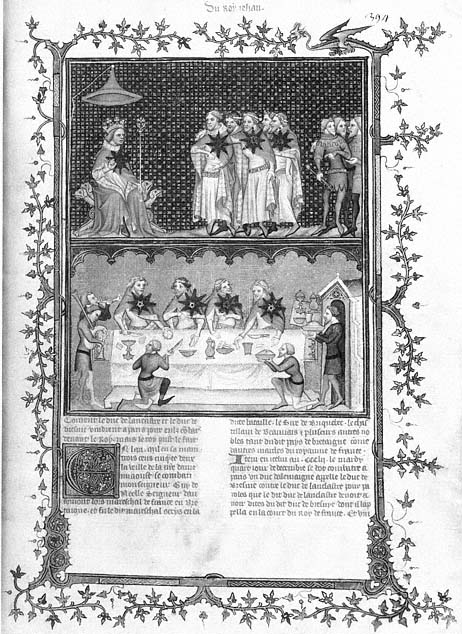
Figure 76
Order of the Star. Grandes Chroniques de France . Bibliothèque Nationale,
Ms. fr. 2813, fol. 394. Photograph: Bibliothèque Nationale, Paris.
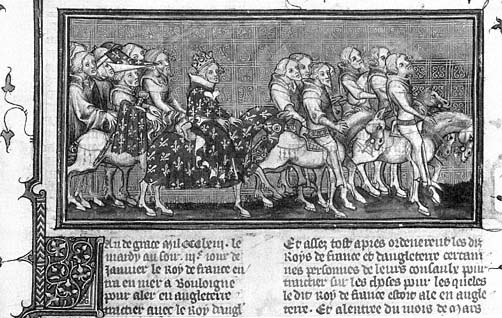
Figure 77
John the Good enters London. Grandes Chroniques de France . Bibliothèque Nationale, Ms. fr.
2813, fol. 438. Photograph: Bibliothèque Nationale, Paris.
significance to the text? The answer lies in the motivation for the founding of the order and in the contemporary perception of its goals. The full title of the order, Company of Knights of Our Lady of the Noble House at Saint-Ouen, gives a clue to its purpose.[12] To create a tighter bond between John and members of the nobility, the order intertwined the cult of the Virgin with a series of regulations that restricted the conditions under which a member could do battle. Ties like the one created by this order became increasingly necessary for the French as loyalties shifted during the Hundred Years' War.
Even more important to an understanding of this picture, however, is the relationship between the Order of the Star and the English Order of the Garter, founded by Edward III.[13] The rules and goals of these orders changed in response to each monarch's need to ensure the loyalty of his troops and, more important, in response to developments on the other side of the channel. Thus the Order of the Star, founded approximately three years after its English counterpart, was a rallying point for French chivalry—a political statement expressing clear opposition to the English and perhaps responding to the Order of the Garter.
The relationship between this miniature and its text confirms the political interpretation of the Order of the Star in France. While the text focuses on the neglect of a treaty by the English and their use of treachery to capture a city, the miniature presents a picture of the victorious French king united with his loyal knights, who stand in opposition to those who threaten the realm. Thus French virtue is contrasted with English decadence.
The only other two-column miniature featuring John the Good offers a more specific glorification of kingly behavior. John's royal entry into London in 1363 (Fig. 77) marked his willing return to captivity after Louis, duke of Anjou,
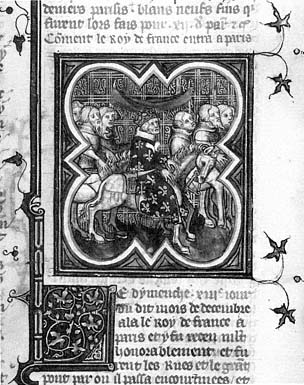
Figure 78
John the Good enters Paris. Grandes Chroniques de
France . Bibliothèque Nationale, Ms. fr. 2813, fol. 436v.
Photograph: Bibliothèque Nationale, Paris.
John's second son and one of the hostages who had taken the king's place in England in 1360, returned to France without permission. This breach of honor, coupled with France's difficulty in meeting ransom payments, broke the Treaty of Brétigny. For John the Good, the only honorable recourse was to return to London.[14] The scale of this miniature highlights the importance to Charles V of his father's honorable behavior. The miniature depicting John's royal entry into Paris when he was released in 1360 (Fig. 78) is of normal size. Only his voluntary return to captivity, a gesture lauded by the French, is shown in large scale.[15]
The Royal Succession
The continuity of the Valois line is the second theme addressed by the ceremonial images in Charles V's Grandes Chroniques . When seen together, miniatures showing the peers supporting the crown at the coronation of Jeanne de Bourbon and Charles V and the baptismal procession of Charles VI assert that the Valois line flourishes in the person of the young heir.
The scene that introduces the narrative of Charles V's life, a double miniature of the peers supporting the enthroned king and queen, is one of the most perplexing in this Grandes Chroniques de France (Plate 4). Historians and art
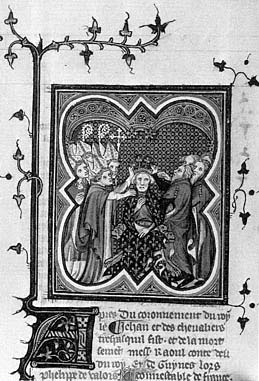
Figure 79
Coronation of John the Good. Grandes
Chroniques de France . Bibliothèque
Nationale, Ms. fr. 2813, fol. 393.
Photograph: Bibliothèque Nationale, Paris.
historians alike have dismissed it from serious consideration because it copies earlier images.[16] Paradoxically, it is precisely this dependence that makes the scene representing Charles's coronation special. Of the 175 pictures in this manuscript, it is one of only two derivative miniatures, a status that raises questions about its function in the Grandes Chroniques . Though derivative, it is not an exact copy of its model. Subtle changes in composition and heraldry, which alter the image to fit its new setting, can be explained by careful consideration of the specific context of Charles V's manuscript and the more generalized context of contemporary historical events.
The image was painted between 1375 and 1377 to decorate a continuation of the Grandes Chroniques , written at court, that ends in a chapter covering two events of 1375: the publication in the Parlement of Paris of the ordinance regulating the majority of the French kings and the making of a treaty with the English at Bruges.[17] Apparently the chronicle was thought complete at this time and was probably bound. This continuation provides the specific context for the miniature.
In the detail employed the portrayal of the ceremony in this miniature differs from depictions in the manuscript of the commencement of other kings' reigns. Compare, for example, the details of the illustration of John the Good's coronation (Fig. 79), painted in the same campaign as the double scene of Charles V
and Jeanne of Bourbon. In this image the fleur-de-lis identifies the coronation as French, but it is impossible to identify the king. In the double miniature the king and queen hold recognizable objects: Charles grasps a scepter representing Charlemagne enthroned, which was made for him and is still preserved in the Louvre, and Jeanne of Bourbon holds in her right hand the scepter of Dagobert, known from eighteenth-century drawings by Montfaucon.[18]
Scholars have explained the specificity of this picture by citing its models—images from Charles V's commemorative Coronation Book (Plates 5 and 6).[19] The Coronation Book , produced in 1365 under Charles V's direct supervision, was decorated by the same workshop that later painted the double picture in the Grandes Chroniques . Because it formed part of the royal library, the Coronation Book was an authoritative and convenient model for the images in the Grandes Chroniques . This relationship provides a plausible explanation for the compositional similarity of the images, but it makes their other differences even more problematic.
One puzzling difference is the moment chosen to illustrate the beginning of Charles V's reign. Instead of the moment of coronation, the picture in the Grandes Chroniques represents a portion of the ceremony that occurred after the coronation proper—a symbolic expression of support for the new king and queen by the clerical and lay peers. The text of the chronicle does not mention this occurrence. It states that the king and queen were crowned and lists some of the nobles in attendance.[20] Strictly speaking, the miniatures of the coronations of Charles V and Jeanne of Bourbon from the Coronation Book would have been more appropriate models if the only goal of this picture were the commemoration of the event recounted in the text.[21]
Another significant divergence from the Coronation Book is evident in the placement of the queen's picture next to the king's. As recorded in the Coronation Book , the ceremony of the queen's coronation was begun only after the king's was finished. The double miniature in the Grandes Chroniques thus juxtaposes two pictures that were separated by 11 folios and as many miniatures in the Coronation Book . This representation of parallel moments from the two ceremonies glosses over the temporal separation between them and, in the process, gives more prominence to the queen, presenting her on an almost equal footing with the king.
The heraldry of the double miniature in Charles V's chronicle is also subtly different from that of its models. In the Coronation Book's treatment of the king's coronation, one image (Plate 5) shows the king flanked by the count of Flanders, the duke of Bourbon, the count of Toulouse, the duke of Anjou, the archbishop of Reims, and the bishop of Beauvais. The corresponding miniature of the queen's coronation (Plate 6) shows the queen flanked by the count of Toulouse, the count of Étampes, the bishop of Beauvais, and the archbishop of Reims.[22]
The positions of three people changed when these scenes were copied into the Grandes Chroniques (Plate 4). In the scene showing the peers supporting the crown after the coronation of the queen, the duke of Burgundy replaced the count of Toulouse, and the duke of Bourbon replaced the count of Étampes.[23] In the scene with the king, the count of Étampes takes the position near the king that the duke of Bourbon held in the Coronation Book .
These careful heraldic changes do not increase the historical accuracy of the picture. Of the peers distinguished by heraldry in the miniatures, the Grandes Chroniques only mentions the presence of the archbishop of Reims; the bishop
of Beauvais; Louis, duke of Anjou; and Philip the Bold, duke of Burgundy at the ceremony.[24] Although not mentioned specifically in the text of the chronicle, the count of Étampes, the count of Flanders, and the duke of Bourbon were peers at the time of the coronation; they were listed as such in both Charles V's Coronation Book and the conflicting list of peers that appeared in the Traité du sacre , the commentary on the ceremony of coronation commissioned by Charles V from Jean Golein in 1374.[25]
Whether the counts of Flanders and Toulouse were really present at the coronation is not germane to this discussion, since the counts appear in both the Grandes Chroniques and the Coronation Book . More intriguing are the differences introduced in the Grandes Chroniques: the duke of Burgundy is brought into the scene of support for the queen, and the positions of the duke of Bourbon and the count of Étampes are changed to place the duke of Bourbon by the queen.
Because the dukes of Bourbon and Burgundy and the count of Étampes were present at the coronation, pictorial or written accounts of the ceremony cannot explain discrepancies between these pictures. In fact, the reason may have been Charles V's concerns for the education of his heir. Charles V's first child, who became Charles VI, was born in 1368 during the period between the execution of the Coronation Book and the Grandes Chroniques de France . The birth of a son, which had been eagerly anticipated for 18 years, ensured the continuity of the Valois line. To safeguard this continuity in the event of his death, Charles V promulgated three ordinances in 1374.[26] One concerned the age of majority. Published in the Parlement of Paris in 1375, it was the subject of the last chapter of Charles V's life in this copy of the Grandes Chroniques . It thus closed the reign that began with the scene of the peers' support. In many ways this ordinance marked a logical ending for this version of the chronicle, which was written and painted between 1375 and 1377, while Charles V was still king. Although it did not complete Charles V's life, it did provide a plan for a smooth transition to his son's government.
A second ordinance, which was not included in the chronicle, charged Jeanne of Bourbon with the education and upbringing of her children and provided her with two principal assistants: her brother-in-law, Philip the Bold, duke of Burgundy; and her brother, Louis, duke of Bourbon. The association of Philip and Louis with the queen in this special charge must have been reason enough to include them with her in this picture and could help to explain why the queen's picture was placed next to the king's—to demonstrate the provisions for legitimate government.
The decision to depict a moment of support rather than the moment of coronation may also reflect Charles V's concern with providing a smooth transition to the government of his heir. A contemporary text, the Traité du sacre by Jean Golein, provides insights into the significance of this ceremony.[27] Completed in the same year as the ordinance on government and contemporary with the painting of the miniature in the Grandes Chroniques , Golein's treatise glosses the events of the coronation with an explanation of their symbolic meaning. In his treatise Golein frequently stresses the peers' role in assisting in the just government of France as defenders of king and realm. According to Golein, "The peers surround the king to signify the forces who surround Solomon, all of them expert with the sword, skilled in battle, because if they [the peers] are not presently holding their swords, they are nearby to be taken when it is time to defend the king and realm."[28]
Perhaps dual images of baronial support were represented in the Grandes Chroniques to show that the peers were ready to defend their present king (Charles V) and to uphold the government of his descendants—a government in which the queen and the peers flanking her were supposed to play an important role.
On the most basic level, this picture is a special commemoration of Charles V's and Jeanne of Bourbon's coronations in 1364, deriving its iconography from the official commemorative manuscript of the coronation. However, this commemorative function may be less important than a second function: to introduce Charles V's reign while simultaneously alluding to its conclusion—to the provisions for government under the young dauphin and the peers' duty to protect and defend the realm and their king, no matter what his age.
Support for this interpretation is found in an analysis of a miniature representing the baptismal procession of the dauphin (Fig. 80), the only other large ceremonial picture from this version of Charles's life.[29] The theme of dynastic continuity to which the miniature of baronial support only alludes is amplified in the representation of the procession that took place in 1368 when Charles's firstborn son was christened. This illustration reflects its narrative, which describes the order of the large procession and lists the distinguished guests in attendance.[30] Of particular interest is the description of Queen Jeanne of Evreux, widow of Charles IV, carrying the dauphin between his two godfathers, Charles of Montmorency and Charles of Dammartin, in the procession to the church. To increase compositional clarity in the miniature, the queen is placed slightly behind the godfathers, in a position that further emphasizes her important role in the event. Prior to the
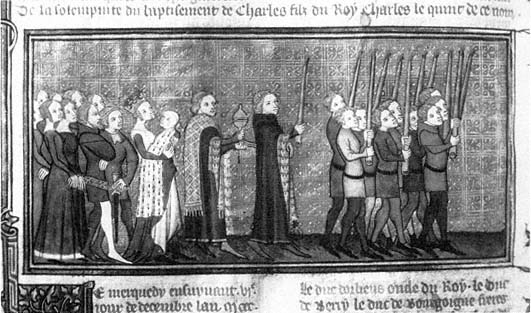
Figure 80
Baptismal procession of Charles VI. Grandes Chroniques de France . Bibliothèque Nationale, Ms. fr.
2813, fol. 446v. Photograph: Bibliothèque Nationale, Paris.
sixteenth century, when descriptions of baptisms of dauphins began to specify that the godfather carried the godchild, there seems to have been no fixed protocol governing this aspect of the ceremony.[31] Therefore, Charles V's choice of Jeanne of Evreux, the surviving wife of the last Capetian king and a constant negotiator for peace between Charles V and Charles of Navarre, is particularly significant.[32] Her role in carrying the Valois heir must have been seen at the time as an affirmation of the continuity between Capetian and Valois—of the sanction of the Capetian kings for their Valois successors.
A contradiction between the accounts of the Grandes Chroniques and the continuations of Guillaume de Nangis's Chronique abrégée raises a question as to Jeanne of Evreux's actual role in the baptism. Dating from the 1380s, the continuations of the Chronique abrégée include a description of the baptism identical to that of the Grandes Chroniques except that Jeanne of Evreux's part in the ceremony is suppressed, and Charles of Montmorency carries the infant, accompanied by Charles of Dammartin.[33] This deviation is notable in a text that copies Charles V's Grandes Chroniques so carefully that it transcribes one of the marginal notes unique to this royal manuscript.[34] The exact significance of this break from the official account preserved in Charles's manuscript remains undetermined. It may be that Jeanne of Evreux's death in 1371, which ended her negotiations between the houses of France and Navarre, also lessened her utility as a symbol of Capetian support for the Valois line. A second possibility is that the compiler of the Chronique abrégée noted an inconsistency in the Grandes Chroniques , which he rectified. The Grandes Chroniques describes Jeanne of Evreux carrying the dauphin but also includes her among the distinguished guests following behind in the procession, "la royne Jeanne, la Duchesse d'Orliens sa fille."[35]
The miniatures that punctuate Raoulet d'Orléans's first continuation of the Grandes Chroniques function differently from those in the earlier portion of the manuscript. Illustrations to the life of John the Good and the first part of the life of Charles V document Charles's gradual consolidation of power. At the same time, a small group of texts and images of ceremony that are unique to this manuscript addresses different issues. Their assertion of French supremacy through illustrations of John the Good's kingship and through the emphasis on the Valois succession in images of Charles VI manifests underlying political and dynastic themes that reach fuller expression in the third part of the manuscript.
Chapter Seven—
The Third Stage of Execution (after 1379)
The third stage of production of Charles V's Grandes Chroniques —Raoulet d'Orléans's second continuation—spans the shortest period, beginning with events of fall 1375 and terminating in April 1379.[1] Unlike the second portion of the chronicle, which documents Charles V's consolidation of power, this part describes a difficult time in France's history. With the exception of the state visit of the Holy Roman Emperor, the events of this era were bleak. After the death of the Black Prince in 1376 and Edward III in 1377, an infant, Richard II, assumed the English throne with a government dominated by his uncles. War with England resumed, the confessions of Jacques la Rue and Pierre le Tertre confirmed the long-suspected treachery of Charles of Navarre, and the Papal Schism began.[2]
During this stage of production several changes were made to earlier portions of the manuscript, and new material was introduced. A new frontispiece was added to the first volume, and four sets of leaves were excised from the lives of Saint Louis and Philip of Valois, written in the chronicle's first stage, and replaced by illustrated texts addressing the question of Valois legitimacy and thus reinforcing many of the themes present in earlier portions of the book. The miniatures executed in Raoulet's second continuation further promote the theme of French kingship by defining the king's relation to the emperor, with particular emphasis on his primacy in France. Indeed, this is a central focus of this continuation: 17 miniatures portray events from the Holy Roman Emperor's visit to Paris in 1378.
The Five Substitutions
The five substitutions of this continuation comprise two texts dealing with homage, illustrated with three miniatures; a third text describing events that surrounded Philip of Valois's succession to the throne of France, illustrated with one miniature; a fourth text, a short prefatory paragraph to the life of Saint Louis, with a full-page frontispiece and author's portrait; and a frontispiece for the whole manuscript. Each of the substituted folios contains textual or visual material unique to Charles V's Grandes Chroniques . Seen together, they constitute a forceful reaffirmation of the legitimacy of the Valois line in response to English claims to the French throne, accomplished in part by the assertion of parallels between Saint Louis and his Valois descendants.
The type of homage owed to the French king by the English ruler for his duchies in France had long been an issue between France and England and was
of particular importance to the early Valois rulers.[3] The dispute was rooted in the Treaty of Paris, concluded between Louis IX and Henry III in 1259, which called upon the French king to cede certain lands to the English king in return for his liege homage. Criticized for having alienated important lands in the treaty in exchange for mere homage, Louis retorted, as Joinville notes, "It seems to me that that which I give Henry III, I use well because he was not my vassal, and because of this event he enters into my homage."[4] The English kings grudgingly renewed their homage at each change of reign: Edward I paid homage to Philip IV of France in 1286, and Edward II paid homage to Philip IV (1308) and Philip V (1320). In none of these cases, however, did the king pay liege homage because he did not swear the oath of fidelity.[5]
When Philip of Valois came to the throne in 1328 he, like his predecessors, summoned the English king to pay homage for his duchies in France.[6] Edward III arrived at Amiens in 1329 but, like his father and grandfather, pledged a less-binding, conditional homage that omitted the oath of fidelity to the French ruler. Twice in 1330 Edward was summoned to appear in France in order to confirm that the homage of 1329 had been liege and to swear the oath of fidelity. In 1331 Edward sent a letter to Philip stating that he should have performed liege homage in 1329; however, he did not make the trip to France and, in fact, never performed liege homage in person.
The issue of liege homage is the focus of two of the four sets of substituted leaves in Charles V's Grandes Chroniques . As Paulin Paris and others have noted, these insertions expand short discussions of homage in the lives of Saint Louis (chapter 84) and Philip of Valois (chapter 6) with three miniatures and the texts of two documents from the Trésor des chartes: the Treaty of Paris and the letter Edward III sent Philip in 1331.[7]
In the first miniature of homage (Fig. 81) Henry III kneels before Saint Louis and clasps his hands while witnesses peer from either side of the royal pair and from the lower margin of the page. Rather than occupying the traditional place at the head of the chapter, this miniature precedes the text of the Treaty of Paris, in which the English king first agreed to pay liege homage to the French king and his heirs for lands in France (Gascony, including Bordeaux and Bayonne, and the channel islands) and to renounce claims to lands held by the French in Normandy, Anjou, Touraine, Maine, and Poitou.[8]
Two miniatures in the second insertion (Figs. 82 and 83) illustrate the letter sent to Philip of Valois in 1331, which not only confirmed that Edward should have performed liege homage in 1329, but also described the form that all future ceremonies of homage should adopt.[9]
The illustrated texts interpolated into the Grandes Chroniques at this stage of production blur distinctions between the homage that took place in 1329 and that which was described in 1331, distorting the actual ceremony of homage to bolster the French position and promote the legitimacy of the Valois line. Textual changes in the manuscript manipulate the description of the events of 1329 to imply that the English king unequivocally accepted the Valois succession immediately after Philip of Valois's accession in 1328, rather than three years later. In addition, the chapter describing the 1329 ceremony of homage incorporates the letter written in 1331, preceded by a paragraph stating that the plain homage paid in 1329 was just like the liege homage described in the letter. Raoulet writes, "Thus the English
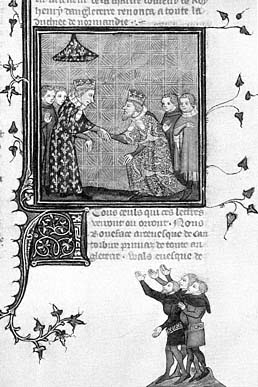
Figure 81
Henry III's homage to Saint Louis. Grandes
Chroniques de France . Bibliothèque Nationale,
Ms. fr. 2813, fol. 290.
Photograph: Bibliothèque Nationale, Paris.
did homage to the king of France in the form and manner contained in the charter sealed with the seal of the king of England, whose content follows."[10] Moreover, to eliminate any shred of doubt, Raoulet further edits the rubric that he had placed at the beginning of the newly-inserted chapter (Fig. 84). The original rubric shows the English king as a less-than-willing participant: "How the king of England went to sea to go to the city of Amiens where the above-mentioned king had to pay homage to the king of France for the duchy of Aquitaine and for the county of Ponthieu as vassal of the king of France [my italics]."[11] Its corrected version, "How the king of England went to sea to go to the city of Amiens to pay homage to the king of France . . . ," suggests that the homage was freely offered.
The illustration that immediately follows this rubric freezes the English king's action as he prepares to kneel and extend his hands to clasp those of the French monarch. The next picture, at the bottom of the folio on which the letter begins, portrays a later moment of the ceremony, drawing its details directly from the description of homage in the letter. In this two-column miniature Edward kneels and places his hands, which are rendered in a scale larger than the rest of the image, within those of the French king. Aiding the French king is his chamberlain, dressed in a long, side-split mantle or hérigaut marked at the shoulder by three bands of white.
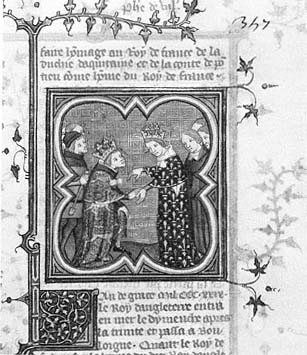
Figure 82
Edward III prepares for homage before Philip of Valois.
Grandes Chroniques de France . Bibliothèque Nationale,
Ms. fr. 2813, fol. 357.
Photograph: Bibliothèque Nationale, Paris.
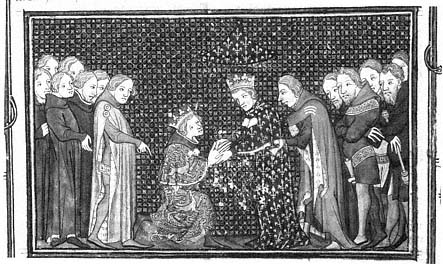
Figure 83
Edward III's homage before Philip of Valois. Grandes Chroniques de France .
Bibliothèque Nationale, Ms. fr. 2813, fol. 357v.
Photograph: Bibliothèque Nationale, Paris.
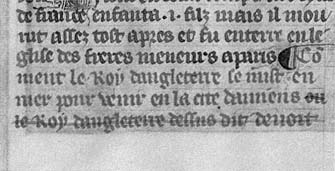
Figure 84
Edited rubric. Grandes Chroniques de France . Bibliothèque
Nationale, Ms. fr. 2813, fol. 357.
Photograph: Bibliothèque Nationale, Paris.
The moment represented in the three illustrations reinforces the political content of their texts. The miniature of Henry III's homage and the two miniatures of Edward III's homage all focus on the gesture of immixtio manuum (handclasp)—significantly, the moment at which the vassal was most abject. This may have been the reason for illustrating it rather than another moment, such as the osculum (kiss). Also significant is the chamberlain's action in Edward's homage, for it marks the instant at which the English king swears the oath and thus submits to French authority. The presence of witnesses in all the miniatures verifies this act of submission.[12]
Additional visual details further stress the English king's submission to his French lord. In all three miniatures the English king wears a heavy gold crown, although the ceremony demands that the person swearing homage be bareheaded. This deviation was doubtless employed to identify both Henry III and Edward III. Indeed, contemporary illustrations of homage such as those decorating Charles's manuscript of the Homages du comtè de Clermont , known through an eighteenth-century copy made for Roger de Gaigniéres, often identify figures through details of dress.[13] In the depiction of the homage of Louis II of Bourbon from this manuscript, for instance, court personages are easily identified by their arms. Further, Louis is not bareheaded while offering homage but wears a thin circlet. Nonetheless, it is tempting to see the addition of crowns to the standard English arms as yet another way of emphasizing the king's submission.[14] The English monarch paid homage in 1259 and 1329 as duke of Gascony and Poitou, not as king of England. His representation in royal regalia presents the event as the homage of a king rather than a duke.
One of a series of contemporary letters documenting the negotiations between Philip of Valois and Edward III, added during the second continuation of Charles V's Grandes Chroniques , describes the ceremonies of plain and liege homage, clearly demonstrating that the only distinction between the two ceremonies was the wording of the oath.[15] The events represented in the added miniatures—the chamberlain's speech for the French king and the immixtio manuum —could therefore have been part of either ceremony. Yet the submission symbolized by the gesture of immixtio manuum seems to have been as important
an issue in the late fourteenth century as the propriety of liege or plain homage had been at the beginning of Philip of Valois's reign. Writers who favored the English side challenged Valois legitimacy by denying that the English king had performed this symbolic gesture, despite the fact that duplicates of the homage documents were available in England. Froissart, in a redaction of his chronicle, possibly identical to that presented in 1361 to the English queen, Philippa of Hainault, included this account of Edward III's homage before Philip of Valois: "The king Edward of England did homage by mouth [i.e., kiss] and words only, without putting his hands between the hands of the king of France."[16] A little later he asserted, "Many murmur in England that their lord was closer to the heritage of France than was king Philip."[17]
The textual source for Book I of Froissart's history—the chronicle of Jean le Bel—gives this account added significance,[18] for the description of homage is one of the few original passages that Froissart interpolated into Jean le Bel's text to produce the first redaction of his chronicle. Since this text was destined for the English queen, the interpolation of an original account questioning the legitimacy of the French ruling house doubtless reflects contemporary English political rhetoric and the importance of the immixtio manuum as a symbol of submission.
The inserted miniatures of homage thus function on three levels: they provide a clear illustration of the inserted documents; they underline the French view of the homage by emphasizing the gesture of submission and by identifying the participants through details of costume; and they illustrate Charles V's historic speech before his uncle, the Holy Roman Emperor Charles IV, in 1378—a summary of which formed part of the continuation of the Grandes Chroniques written at the same time that the insertions were substituted into earlier portions of the manuscript.[19]
This speech, given before the royal council and the university community, outlined a litany of English provocations justifying the French resumption of war. Charles V opened his discourse with a description of the two incidents of homage, which are painted with extraordinary care and added to the manuscript. He then discussed the Treaty of Brétigny and the letter of confirmation that outlined the renunciations to which the English agreed. He further explained how, at each turn, the English had broken their word; they aided Charles of Navarre and condoned the Black Prince's atrocities in France. He emphasized that the French continued, despite these breaches of faith, to send messengers beseeching the English to rectify matters. Finally, Charles concluded, his nation had no alternative but to resume war with the English.
The summary of Charles's speech places great emphasis on proof of his assertions. References to documents shown to the emperor appear throughout. For example, the emperor was shown the "letters on this matter" (the letter of 1331 on homage); the "other, older charters" in which the "kings of England renounced lands" (Treaty of Paris); and the "treaty of the peace" (Treaty of Brétigny). Almost all these texts either already appeared in the Grandes Chroniques or were inserted into Charles V's personal copy during Raoulet's second continuation.
Charles V's speech had an impact on other portions of the manuscript as well. Marginal notes added by Raoulet d'Orléans single out almost all the other events cited by Charles V in his discourse and described earlier in the Grandes
Chroniques . Although notas are the most common form of annotation, detailed marginalia occasionally single out texts because of their relationship to the speech. One annotation even corrects a text (chapter 20) written during the second stage of execution, which states that the Black Prince imprisoned representatives of Charles V for a long time and "still holds them, in great contempt of the king and his sovereignty."[20] Next to this statement is a marginal note, underlined and framed by brown pen lines, which states, "Note: he had them killed."[21] This note updates the earlier continuation to conform with the version of the story given by Charles V in his speech when, in listing the excesses of the Black Prince, he said that the prince "had them taken and murdered evilly, against God and justice and in offense of the king and the realm of France."[22] This example is one of many that prove how carefully the director of the manuscript's layout underscored the relation between portions of text executed during the first and second stages of the manuscript and that portion written after the emperor's visit in 1378. The introduction of new texts containing specific images and the addition of complex marginal notes to texts already present in the manuscript draw attention to events and documents cited in Charles V's speech.
The third substitution of texts and images focuses exclusively on the problem of Valois legitimacy. In Charles V's Grandes Chroniques the first chapter of the life of Philip of Valois substitutes, as Paulin Paris and Jules Viard note, a description of Philip's uncontested accession to the throne for the traditional discussion outlining English and Navarrese claims.[23]
The care with which this alteration was accomplished is striking. Text, rubric, and illustration differ from their counterparts in all other Grandes Chroniques . The miniature of the coronation of Philip of Valois at the head of the first chapter initially appears to be a logical choice for the first illustration to a king's reign (Fig. 85) and, understandably, has not attracted attention. Yet almost every other manuscript of the Grandes Chroniques postdating Charles's copy provides a different image and rubric. Instead of the coronation, events such as a discussion between barons, a homage, or a battle are most commonly illustrated.[24]
A correction to the list of chapters dealing with Philip of Valois, which has been overlooked by compilers of critical editions of the Grandes Chroniques , suggests that the text surviving in later manuscripts, and most often illustrated by the baronial debate, may also have been the original in Charles V's copy. At the beginning of the chapter list on a folio written by Henri de Trévou (Fig. 86) an unknown rubric for chapter 1 was carefully scraped and the coronation rubric substituted by Raoulet d'Orléans. This new rubric ("How Philip, Count of Valois, received the government of the realm and of his coronation") may in fact have replaced the same rubric as that found in later manuscripts ("The first chapter addresses the question of to whom the government of the realm should be entrusted").[25]
Just as the changed rubric and text in Charles V's Grandes Chroniques gloss over the difficult transition from Capetian to Valois, the new miniature also portrays a smooth transfer of power. By illustrating Philip of Valois's coronation, this miniature underlines his continuity with those who had reigned before. Few modern readers looking at the revised account in Charles V's manuscript would suspect that Philip's accession contributed to the Hundred Years' War.
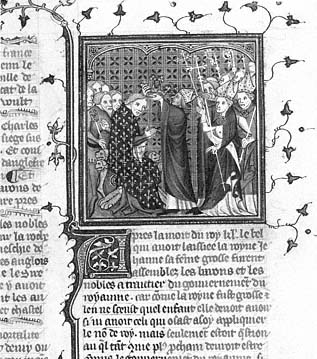
Figure 85
Coronation of Philip of Valois. Grandes Chroniques de
France . Bibliothèque Nationale, Ms. fr. 2813, fol. 353v
Photograph: Bibliothèque Nationale, Paris.
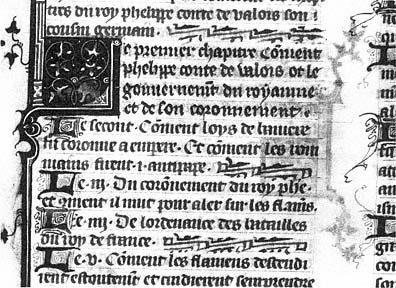
Figure 86
Chapter list, life of Philip of Valois. Grandes Chroniques de France .
Bibliothèque Nationale, Ms. fr. 2813, fol. 352.
Photograph: Bibliothèque Nationale, Paris.
The fourth insert, the frontispiece to the life of Saint Louis (Fig. 87), contains six scenes: the nativity of Saint Louis, the education of Saint Louis, Saint Louis's care for the leper monk at Royaumont, Saint Louis washing the feet of the poor, the burial of the crusaders' bones at Sidon, and Saint Louis's submission to scourging by his confessor. These images reflect the Valois interest in the royal saint,[26] glorifying him as the ancestor of the Capetian and Valois lines and thus reinforcing the theme of dynastic legitimacy conveyed by the other inserted texts and illuminations.
Like Philip of Valois and John the Good, Charles promoted dynastic legitimacy by invoking his direct Valois ancestors and his saintly Capetian ancestor, Louis.[27] To stress continuity within the new dynasty, Charles decided to be crowned on Trinity Sunday, as his grandfather had been.[28] In another expression of dynastic pride, undertaken shortly after his coronation, he commissioned tombs for both his grandparents, Philip of Valois and his first wife, Jeanne of Burgundy; his father, John the Good; himself; and his queen, Jeanne of Bourbon, to make the first three Valois kings visible near their Capetian, Carolingian, and Merovingian ancestors in the royal necropolis at Saint-Denis.[29]
Even Charles's ordinance establishing the age of majority at 14 invoked Louis IX above other French kings. The text, whose publication in Parlement in 1375 was the subject of the last chapter of the second stage of execution of Charles V's Grandes Chroniques , cites Saint Louis among biblical and historical exempla of kings who assumed their majority at 14, even though historical evidence suggests that Louis IX was, in fact, 12 at the time.[30] A long passage in praise of Saint Louis as patron of France and as a model of good kingship follows.[31]
The inserted frontispiece to the life of Saint Louis constitutes a part of this pervasive Valois tradition. Like many Capetian commissions and like John the Good's Grandes Chroniques , its textual source is the Vie de Saint Louis by Guillaume de Saint-Pathus. Although most of its imagery derives from Saint-Pathus as well, certain deviations from established iconography are distinctive.[32]
The most innovative scene in the frontispiece, the nativity of Saint Louis, is the only miniature with no textual nor pictorial basis. Its inclusion establishes a relationship between the baby Louis and Charles V's infant son, later Charles VI, as he appears in the large two-column miniature of his baptismal procession from the chronicle's second stage of execution (Fig. 80). This comparison is relevant because Charles V and Jeanne of Bourbon had waited 18 years for the birth of their son. Their desire for an heir was strong enough to cause changes emphasizing fertility in the coronation ordo used in 1364.[33]
Almost every other Grandes Chroniques that illustrates Charles VI as a baby also includes a portrait of his younger brother,[34] nor does any other Grandes Chroniques picture Saint Louis as an infant. By omitting a picture of the birth or baptism of Charles's second son, Louis, in 1372 and including a picture of an infant whose presence is not even demanded by the text, this Grandes Chroniques establishes a connection between the dauphin Charles and Louis IX that underscores the expression of Capetian-Valois continuity in the insertions of homage and of the coronation of Philip of Valois.
A second scene in the frontispiece is more concerned with Louis's kingship than with his place in Valois genealogy. An image of Blanche of Castille, enthroned and supervising the education of her son, normally illustrates copies
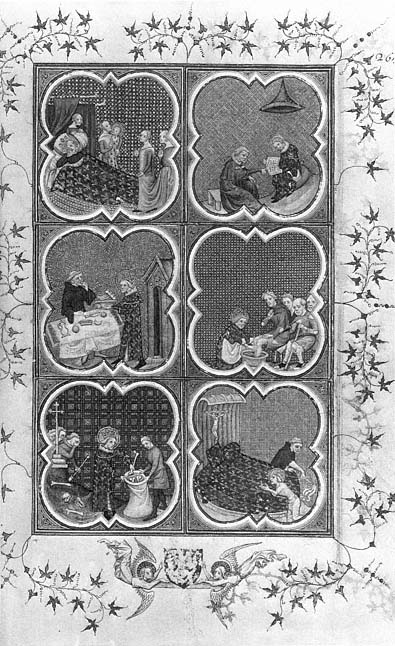
Figure 87
Frontispiece to the life of Saint Louis. Grandes Chroniques de France .
Bibliothèque Nationale, Ms. fr. 2813, fol. 265.
Photograph: Bibliothèque Nationale, Paris.
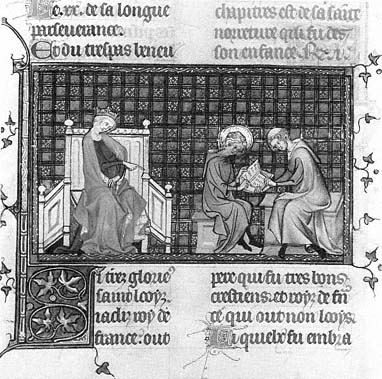
Figure 88
Blanche of Castile oversees Louis IX's education. Guillaume de
Saint-Pathus, Vie de Saint Louis . Bibliothèque Nationale, Ms.
fr. 5716, fol. 16. Photograph: Bibliothèque Nationale, Paris.
of Saint-Pathus's Vie (Fig. 88), which supplied the model for the illustration of the education of Saint Louis in the Grandes Chroniques .[35] In the frontispiece the suppression of the queen and the changed relationship between teacher and pupil transform its tone. The authority of Louis's royal dress, his prominent position under a baldachin with his teacher on a low bench before him, and the absence of his mother shift the emphasis to Louis's kingship and away from the more conventional presentation of the instruction of a prince. This altered focus may reflect a changing ideal of kingship under Charles V, who earned his sobriquet, "the Wise," through his scholarly pursuits and who was often cited along with Saint Louis in discussions of the education of a French king.[36]
The fifth and final insert in Charles V's Grandes Chroniques is a miniature long thought to represent the coronation of Charles VI (Fig. 89). Scholars traditionally believed that this image was executed for the section of the manuscript that followed Charles V's life, then cut out and placed at the beginning when the two volumes of Charles V's manuscript were rebound as one in the fifteenth century.
The most persuasive argument against this interpretation is that Charles V's Grandes Chroniques ends abruptly in 1379, a full year before Charles's death and his
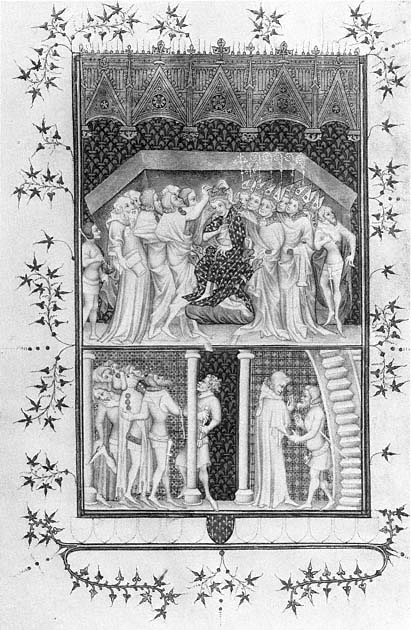
Figure 89
Peers support the crown. Grandes Chroniques de France . Bibliothèque
Nationale, Ms. fr. 2813, fol. 3v. Photograph: Bibliothèque Nationale, Paris.
son's accession: there could have been no text describing Charles VI's coronation. Moreover, there is no evidence that an account of the coronation was ever there. Over 50 blank pages are ruled at the end of the manuscript with no sign that anything has been cut out. The simplest explanation may therefore be that this coronation scene was inserted, along with the other pages, in the third stage of execution of the manuscript. Indeed, it may have been planned to serve as a full-page frontispiece to the first volume of the Grandes Chroniques , just as the inserted leaf with scenes from the life of Saint Louis acted as an extratextual frontispiece to the second volume of the chronicle.
The coronation miniature makes more sense in this context. It represents precisely the same moment chosen to introduce Charles V's life in his manuscript—the moment when the king is supported by the peers—but it serves a slightly different purpose here. In Charles V's life the image is packed with realistic details and heraldic charges, reflecting the specific problems with legitimacy and succession that Charles V faced in the 1370s. This frontispiece is more universal; it even includes spectators in the lower register. The fleur-de-lis drapery in the image of the monarch and in the background identifies the coronation as French, but no other figure in the scene is identified by heraldry. Instead, 12 blank shields are isolated on the ground in the lower margin, probably designed to receive the arms of the 12 peers who, according to tradition, assist in the ceremony. The image therefore celebrates France's sacred kingship and alludes to the peers' role, specified by Golein, in supporting and defending the king and the realm.
The Visit of the Holy Roman Emperor
The description of the emperor's visit to Paris in 1378 is the most densely illuminated segment of text in Charles V's Grandes Chroniques .[37] In this subcycle, 18 miniatures decorate 13 folios. They portray the visit from the arrival of the emperor's letter announcing his impending trip (fol. 464) to letters received at court after his departure (fol. 480). The action between concentrates on ceremony. In this portion of the chronicle, text and image together emphasize the preeminence of the French over the emperor. For example, two miniatures illustrate the chapter in which the emperor stayed in the imperial city of Cambrai at the insistence of Charles's messengers, so that he could play his customary imperial role in the religious ceremony celebrated at Christmas without interfering with Charles's kingly role. The first miniature shows the pomp of his entry into Cambrai and the second his part in the celebration of the Christmas mass. The Grandes Chroniques's text makes the issue clear: "Because the emperor customarily said the seventh lesson at matins, dressed in his imperial clothes and insignia, he was advised by the king's men that he could not and would not be permitted to do this in the king's realm."[38] The second miniature shows the imperial ceremony in such detail that the first few words of the seventh lesson, which the emperor declaimed, are inscribed on the book placed on the podium.[39]
Other miniatures in this section of text are notable for their scale as well as for their close relation to their texts. For instance, a sequence of three miniatures (fols. 469, 470, 470v) illustrates the emperor's approach to Paris, the meeting of emperor and king, and their entry into Paris; the miniatures increase in size from
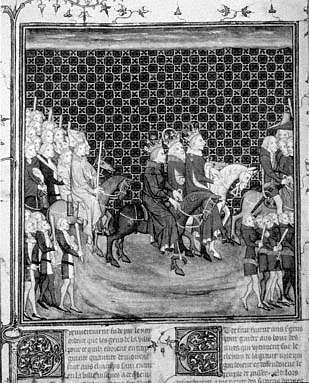
Figure 90
Entry of Charles V, Charles IV, and Wenceslaus into Paris.
Grandes Chroniques de France .Bibliothèque Nationale,
Ms. fr. 2813, fol. 470v.
Photograph: Bibliothèque Nationale, Paris.
one and one-half columns, to two columns, to three-quarters of a page.[40] As in the picture of the emperor in Cambrai, these images stress French ascendancy. The Grandes Chroniques records that Charles V, in order to emphasize the ban on imperial signs on French soil, purposefully chose dark horses, rather than the white ones traditionally given to emperors, for Charles IV and his son Wenceslaus when they met the French king outside Paris. In the illustration of the entry (Fig. 90) the emperor and his son ride dark horses while Charles V sits astride a white horse and wears a crown in place of the hat required by the text.[41] It is likely that this detail of costume was introduced to emphasize Charles's equality with the Holy Roman Emperor.
The largest and most problematic miniature in the subcycle of the imperial visit is that of the Great Feast (Fig. 91). This picture, along with the Order of the Star miniature discussed in Chapter 6, is one of only two illustrations in Charles V's manuscript referred to directly in its accompanying text. As in the image of the Order of the Star, the passage preceding the miniature of the Great Feast refers explicitly to the picture that follows: "And thus they went without a great hurry . . . to the large dais with the marble table and the grouping of figures and
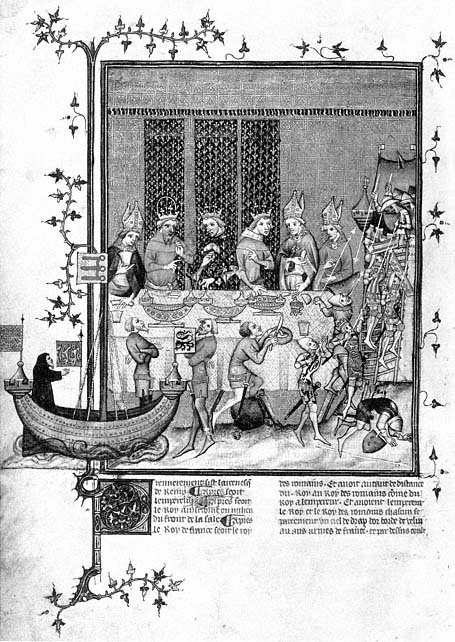
Figure 91
Great Feast. Grandes Chroniques de France . Bibliothèque Nationale, Ms. fr. 2813, fol.
473v. Photograph: Bibliothèque Nationale, Paris.
their positions were as described below and as is figured in the miniature hereafter portrayed."[42] With the exception of a few simplifications required to depict a large crowd in a small area, the illustration conforms to the description of the diners that begins just below the picture. It records the positions of Emperor Charles IV, Charles V, Wenceslaus, and the bishops who dined with them. The representation of the play, which fills the right side and the foreground of the miniature, however, contains elements not specified by the text. The Grandes Chroniques states that the play was about the history of Godfrey of Bouillon and the conquest of Jerusalem. It speaks of Peter the Hermit, of Godfrey, and of the "noble knights who were at the conquest of Jerusalem," but it does not identify these knights. The picture, however, includes four sets of arms, on the boat and on the individual knights who storm Jerusalem: Godfrey of Bouillon's arms are at the stern of the ship at the far left, England's are on a spear, Auvergne's on the mast, and Flanders's at the bow.
Contemporary descriptions of this crusade demonstrate that the storming of Jerusalem portrayed in the miniature includes at least two anachronisms. Godfrey was not king during the assault on Jerusalem; he was crowned later.[43] Further, the counts of Flanders and Auvergne participated in the assault, but the king of England was not there. Instead, his brother, Robert of Normandy, took part.[44] Artistic error alone cannot explain the latter discrepancy; besides adding an extra lion to the arms of Normandy, thus transforming Normandy's two lions into England's three, the artist also placed a crown on the head of the figure who bears these arms and stands at the foot of the ladder outside Jerusalem's walls. Clearly the artist intended to portray the king of England.[45]
The description that the Grandes Chroniques gives for selecting this play provides a possible explanation for these changes. According to the chronicle, the king chose to have the story of Godfrey of Bouillon performed because he believed that there was no better example to put before the noblest men in Christendom who "were best able, ought, and should undertake such a feat in the service of God."[46] Taken at face value, this statement suggests that the play was intended to kindle crusading fervor in those who watched it. This is difficult to prove, since there is little evidence that Charles V was ever seriously interested in a crusade.[47]
A comparison of this image with that of the Order of the Star suggests a different explanation for its prominence in the manuscript. Not only are the miniatures of the Order of the Star (Fig. 76) and the Great Feast (Fig. 91) thematically related, they are also large in scale, occupying three-quarters of a manuscript page; they incorporate elements not described in the chronicle; and they are the only two miniatures in the manuscript to be referred to explicitly by their texts. It is possible that the picture of the Great Feast, painted in the third stage of execution, was designed to refer back to the Order of the Star, painted in the second stage, just as other miniatures and texts from the third stage refer back to the second.
As we have seen, the miniature of the Order of the Star celebrates John the Good and French chivalry and, by contrast, denigrates the English whose treachery is the actual subject of the text it illustrates.[48] Given the relationship between these miniatures, it is reasonable to suggest that the Great Feast may have had a similar function within the framework of the imperial visit. The portrayal of the English king in the capture of Jerusalem when it was known that he did not participate
suggests that its function was to convey a message about England similar to the message conveyed in Charles V's speech.[49]
One of Charles's goals for the imperial visit was to persuade the Holy Roman Emperor to condemn England's actions in the Hundred Years' War. The plea he delivered before the emperor the night after the state dinner at which the play was performed (and recorded in the text of the Grandes Chroniques two chapters after the description of the dinner), presented a litany of dastardly English deeds that contrasted markedly with the portrayal of the English monarch in the play.[50] Charles described an English king who broke treaties and ordered the murder of emissaries, but the crusading play portrays a heroic English king assisting in a triumph over the infidel. Whether this idealized king is Richard the Lionheart, a hero of the Third Crusade, or simply an invention of the designer of the play or program of decoration is unimportant. His heroic stature emphasizes the evil of Edward III as Charles described him. This contrast between exemplary and reprehensible behavior in picture and text is very similar to that established by the Order of the Star miniature and text.
The portrayal of the arms of Flanders and Auvergne in the Great Feast miniature may constitute an additional contemporary reference. Of all the nobles who were with Godfrey when he stormed the walls of Jerusalem only the counts of Flanders and Auvergne accompany him in this miniature. They may have been selected because the counties of Flanders and Auvergne belonged to Philip, duke of Burgundy, and John, duke of Berry, two of Charles's brothers, who played important roles in the protocol of the emperor's state visit.[51] The depiction of their predecessors as counts in the play may have been a compliment to them.
By analyzing the three stages in the production of Charles V's Grandes Chroniques we can thus chart the changing concerns of one French king. As first conceived, the book ended with the life of Philip of Valois and was illustrated with generalized pictures whose images reflect the young king's particular concerns: the history of his ducal predecessors in Normandy; his holy ancestors, Charlemagne and Saint Louis; the concept of legitimacy; and the idea of empire.
During the second stage of execution the text was expanded to include the reigns of John the Good and Charles V to the events of 1375. One series of pictures focuses on Charles's difficulties with Étienne Marcel and the Estates General and with Charles of Navarre, carefully incorporating detail drawn from the chronicle into illustrations that relate exclusively to their own texts. A second series of miniatures depicts ceremonies. These pictures not only illustrate events described in the text but also work together to develop dynastic themes—the promotion of John the Good as a model of good kingship and the assurance of Valois continuity in the person of the dauphin Charles.
Perhaps as a response to the worsening political situation in France, the use of miniatures of ceremony was more common during the third stage of execution. All but two of these illustrations assert French ascendancy over the empire. Finally, Valois legitimacy is emphasized by four illustrated texts and one full-page miniature executed during the third stage for substitution into the first portion of the manuscript.
Charles V's Grandes Chroniques is radically different from those versions that went before. Unlike its predecessors, it includes a continuation written at court that brings it up to the present and describes the acts of its patron. Perhaps
because Charles V was a politically astute monarch as well as a noted bibliophile, pictures and text in his Grandes Chroniques were altered almost every time the political situation changed. His chronicle therefore records events of his reign and reflects his changing political thought and contemporary French propaganda during a stressful time in French history. During Charles V's lifetime the book was probably available only to the king and a select group of courtiers. Nevertheless, this Grandes Chroniques addresses the same issues as the more public celebrations of monarchial authority expressed in speeches, ordinances, or ceremonies. This book, which survives while more ephemeral public art has been destroyed, is thus an important historical document that, as we shall see, had a profound influence on subsequent copies of the text.